 |
|

|
 |
TABLE of CONTENTS
 |
Groundhog Day storm wallops south, central parts of state |
By Sue Roe
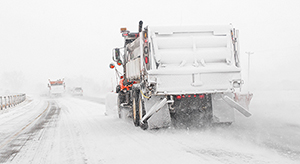
Snowplows clear Interstate 35 Feb. 2 near Owatonna during the winter storm that swept through southern and central Minnesota. Photo by David Gonzalez |
The south and central portions of the state contended with the first real snowstorm of the season on Groundhog’s Day. All state and U.S. highways south of Hwy 14 closed, including Interstate 90, Tuesday afternoon and travel was not advised due to the blizzard conditions.
Snowfall amounts topped more than 13 inches in some areas. MnDOT crews were out overnight to improve road conditions, but some trucks were pulled in due to the snow and wind continuing through Tuesday night into Wednesday. The Minneapolis-St. Paul Airport, the official state weather reporting station, reported 8.8 inches of snow, which broke the record for Feb. 2.
Motorists were advised to check the road conditions on 511, to slow down and to be patient. By Wednesday, most major roads reopened, but MnDOT cautioned motorists that challenging winter driving conditions continued to exist. Several weather advisories were still in effect through noon Wednesday.
From Tuesday morning to Wednesday morning, the State Patrol reported that statewide, there were 475 vehicles off the road. There were 449 property damage crashes and 39 injury crashes.
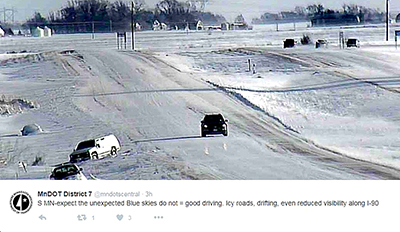
District 7 tweeted this photo on their Twitter page Feb. 3 to encourage drivers to slow down after several vehicles went in the ditch on Interstate 90. |
Motorists used 511 to the tune of 353,421 views, compared to an average weekday of 76,104 views. Most clicked pages were the 511 traffic page, traffic cameras page and the MnDOT home page.
Crews in District 7 were called to help at an explosion and fire in Madelia early Wednesday. Jed Falgren, assistant district engineer, said all roadways to Madelia were closed at the time due to the storm.
“About 5 a.m. the decision was made to haul additional water from the cities of St. James and Lake Crystal, each approximately 12 miles from the scene,” Falgren said. “We maintained trucks on both directions of Hwy 60 to keep the roadway open for the mutual aid fire departments. We also sent a motor grader to open both exits into Madelia.”
Sue Mulvihill, deputy commissioner and chief engineer, said although the short amount of time the snow fell in, along with the wind, posed challenges for crews, they did outstanding work to get roads cleared.
“It’s tough out there during those white-out conditions and our crews worked hard to open highways and get traffic running again. We appreciate their work,” Mulvihill said. |
 |
|

|
 |
TABLE of CONTENTS
 |
Transportation will play role in statewide plan to prevent, end homelessness |
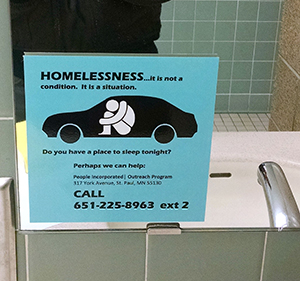
One way MnDOT is reaching out to the homeless is by putting decals on rest area mirrors that have phone numbers for people to call for outreach services. The decals read: “HOMELESSNESS…it is not a condition. It is a situation. Do you have a place to sleep tonight?” Currently the decals are being used at the St. Croix travel information center, and the Elm Creek, Forest Lake and Daytonport rest areas. Photo courtesy of Rob Williams |
Commissioner Charlie Zelle was among 11 state commissioners Jan. 28 who approved an updated two-year action plan for Minnesota’s ongoing efforts to prevent and end homelessness.
The commissioners, part of Gov. Mark Dayton’s Minnesota Interagency Council on Homelessness, created the plan and outlined strategies and actions for their agencies in “Heading Home: Minnesota’s Plan to Prevent and End Homelessness, 2016-2017.” The first two-year plan was developed in 2013.
“Ensuring everyone has a safe place to live will strengthen our families and communities. Evidence shows that when Minnesotans have access to affordable housing, they do better in school, stay healthier, and are more productive at work,” Gov. Dayton wrote in a letter introducing the plan, noting that since 2014, the state has reduced homelessness by 10 percent statewide and 17 percent for families with children.
“Because reliable transportation is necessary to maintain stable employment, access to childcare and other necessary resources, MnDOT is committed to continuing to work to increase access to transportation for those experiencing housing instability,” Zelle said at the Jan. 28 meeting.
The plan identifies three main roles for MnDOT:
- Increase access to transportation for those experiencing housing instability by:
- Gathering data on transportation barriers
- Addressing transportation barriers in the five-year update to the Greater Minnesota Transit Investment Plan
- Aligning MnDOT’s work in the Heading Home Plan with its work on the Olmstead Plan (whose purpose is to ensure people with disabilities are living, learning, working, and enjoying life in the most integrated setting)
- Training MnDOT staff to have more effective interactions with people experiencing homelessness
- Increase partnerships with regional and metro transportation bodies through the work of the Minnesota Council on Transportation Access and with the Metropolitan Council
Staff leading MnDOT’s effort include Sue Mulvihill, deputy commissioner and chief engineer; Tim Henkel, Modal Planning and Program Management Division director; Dan DuHamel, Division Business Manager and Special Projects director; Noel Shughart, Office of Transit program team leader; and Emily Parks, project coordinator.
“We look forward to seeing the effect of our efforts over the next two years,” Zelle said.
For additional information about the project, contact Emily Parks. |
 |
|

|
 |
TABLE of CONTENTS
 |
Dash cameras improve snow removal operations |
|
By Sue Roe
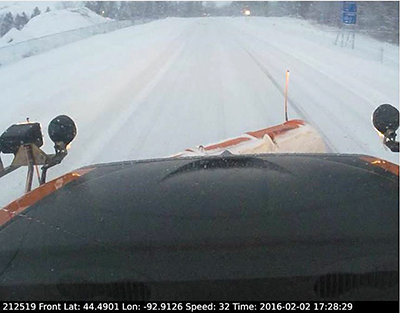
This photo is from a dash camera mounted in a MnDOT snowplow. The images are available to maintenance supervisors to decide what resources to use and when to use them. |
Dash cameras are being installed in some snowplows this winter to capture the images operators see as they clear the roads. The images will help maintenance supervisors make better decisions about what resources to use and when to use them.
A total of 226 snowplows, or about a fourth of the snowplow fleet, are being outfitted with the dash cams, according to Joe Huneke, program team leader of the Road Weather Technology Group.
The dash cams interface with the Automated Vehicle Location system already installed in those snowplows. The AVL system uses GPS technology to record snowplow locations, road conditions, weather conditions, sander controller data and other information, and then collects and transfers the information and dash cam images to a data server that maintenance supervisors can access.
“The cameras show real-time road conditions directly from the trucks, giving supervisors and managers visual information to make informed winter operations decisions,” Huneke said. “Supervisors can evaluate the conditions without having to drive the route themselves. They can also evaluate the effectiveness of the maintenance activity on the road and see if any adjustments need to be made with applications or other resources.”
Dash cams are primarily being used on high-volume roads such as Interstate 35 and I-90 in Greater Minnesota, Huneke said. When all the cameras are installed, they will be evenly distributed around the state for constant coverage.
The camera is mounted on the dash of the snowplow or on the cab’s ceiling. It records a “front seat” image of the road ahead. Images are taken once a minute and are only retained if the plow is moving at least 10 miles per hour.
Huneke said when the AVL system is on, the dash cams are automatically recording images. Audio is not part of the system.
The images are kept for 14 days, as required by MnDOT’s data retention policy.
The cameras are also capable of taking operator-initiated video. When a video is taken, a message is sent to district staff to download from the system. The data retention schedule allows time for downloading of the video to a laptop computer, if needed.
Videos saved on the onboard computer are marked as accident, general interest, police support or work zone intrusion in case they need to be retrieved later for specific reasons.
Phase two of the project will place the existing images on the 511 system so the public can view current road conditions. Plans are to have the images available on 511 by September.
“The goal is to provide the users of 511 and maintenance managers with a near real-time visual tool to make informed decisions,” Huneke said.
Research Services provided funding for the cameras in 2015. |
 |
|

|
|

|
 |
TABLE of CONTENTS
 |
Willow shrubs are latest form of living snow fence |
|
By Micheal Foley, Research Services and Library
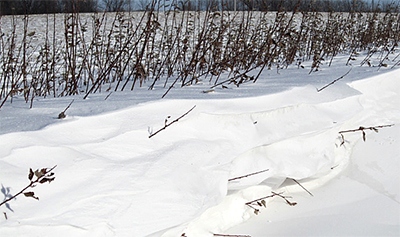
The willow shrubs shown above are part of a study to see if the less expensive plants would make good living snow fences. Photo courtesy of Research Services |
The benefits of living snow fences and other snow control tools to keep roadways clear of blowing and drifting snow have been known for decades, and MnDOT has used a variety of these techniques for years to catch snow before it gets to a road.
Living snow fences often consist of trees, grasses and even corn stalks left standing in a farmer’s field. Now willow shrubs are being added to the list as a fast-growing, inexpensive snow control measure.
What’s new
Researchers recently completed a study that investigated whether willow shrubs could make good living snow fences. While typical snow-fence plants, such as dogwood or cranberry shrubs, take five to 20 years to establish themselves, shrub willows were effective at trapping snow after just two growing seasons, according to the study.
In spring 2013, researchers installed three varieties of shrub willow side-by-side in two-row and four-row configurations along about a quarter of a mile of Hwy 14 in Waseca, where snow drifts are an issue. In April 2014, they cut the shrubs down to the ground to encourage branching and bush density. Although the trimmed willows had little impact on drifting snow the first winter, each willow-shrub plot collected two to three metric tons of snow by the second winter, according to the research report. Researchers believe that after three or four growing seasons the willow shrubs could catch the entire mean annual snowfall on the site.
In the four-row configuration recommended by researchers, costs of raising, furnishing, planting and mulching came to about $3.60 per plant, which is dramatically less than the contract bid cost for traditional living snow species that cost more than $50 per plant. In addition, the willow shrubs can be harvested and sold as an energy source called biomass every few years to provide an income source.
Past research
Willow shrubs are just the latest advancement in the state’s snow control program.
A 2012 research project evaluated the costs and benefits of living snow fences and provided MnDOT with a payment calculator to determine how much to compensate landowners for installation and maintenance costs.
A recent research implementation project created a mobile friendly Web version of the payment calculator tool. The website also contains a tool for designing a snow fence.
MnDOT used these tools and other promotional efforts to nearly double the number of farmers with contracts for corn rows enrolled in the Living Snow Fences program.
What’s next
The willow species recommended by researchers will be evaluated further in 2017 when they install it as a living snow fence on a new construction site on Hwy 60 between Windom and Mountain Lake. Researchers also recommend a future study to compare volume of road salt use before and after installation. They also want to look into identifying appropriate buffer distances to keep willow roots from interfering with cropland root systems. |
 |
|

|
 |
TABLE of CONTENTS
 |
Tribal-State Relations training builds effective relationships with Minnesota tribes |
By Judy Jacobs
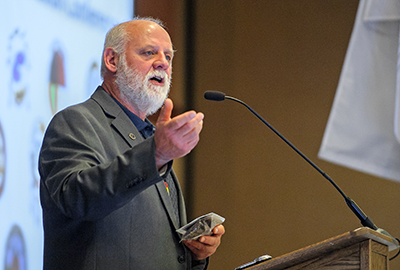
Ed Fairbanks, MnDOT’s Tribal liaison, speaks at a Tribal – State Relations Training session. During the training, state agency employees have an opportunity to learn more about Minnesota’s 11 tribal nations. Photo by David Gonzalez |
Hau mitakuyepi
(Hello my relatives – Dakota language)
Minnesota is home to 11 sovereign tribal nations, four Dakota and seven Ojibwe tribes, who collectively represent the ninth largest employer in the state, and the majority of the state’s 61,000 American Indians. Since 2013 state agency employees have had the opportunity to learn more about Minnesota’s tribes and have been able to interact directly with them through an expert-led Tribal-State Relations Training program.
The training is conducted as a partnership with University of Minnesota Duluth’s Indian Studies and Continuing Education program. Staff have held 12 sessions at tribal locations across the state, training 1,107 state agency employees from the departments of health, commerce, human services, transportation, pollution control, public safety, natural resources, education and revenue, and others. The majority of state commissioners, and their executive staff, have adopted policies for tribal consultation from information gathered at this training.
Charlie Vig, chairman of the Shakopee Mdewakanton Sioux Community, and Sue Mulvihill, MnDOT’s deputy commissioner and chief engineer, welcomed a crowd of 113 attendees to the most recent session, held Jan. 25-26. The Shakopee Mdewakanton Sioux Community hosted the training at the Mystic Lake Casino, Hotel and Event Center.
“Attending this training helps us build a better understanding and insight into tribal culture and tribal land issues,” Mulvihill said. “Gov. Dayton and all department commissioners support this training. It will help us work together better.”
Gov. Dayton’s Executive Order 13-10, effective August 2013, states, “the State of Minnesota and the Minnesota Tribal Nations significantly benefit from working together, learning about one another and partnering where possible.”

Tribal-State Relations Training sessions have taken place at tribal locations across the state. State agency employees attend the training to learn more about tribal culture and tribal issues. Graphic created by Libby Schultz |
Trainees were immersed in tribal culture, beginning with an opening ceremony with the Ringing Shield Drum Group (the LaPointe family), a lesson in Dakota language, an interactive tribal lands map and reflections from a boarding school survivor. Tadd Johnson, director of UMD’s Indian Studies program, presented Federal Indian Law and policies, treaties and executive orders that have affected tribal nations and American Indians since the 1700s.
Break-out sessions on the second day included:
- Answers to historic and cultural questions
- Tribal liaison panel: Interacting with the tribes-meaningful and timely consultation
- Cooperation and coordination: State agencies working with tribal counterparts
A panel presentation, with elected tribal leaders from Shakopee Mdewakanton Sioux Community, Lower Sioux Indian Community, Upper Sioux Community and Leech Lake Band of Ojibwe, shared their recommendations on how to consult and build partnerships with American Indians.
“It’s very important to remember that tribal nations are not stakeholders,” said Ed Fairbanks, MnDOT’s tribal liaison. “Minnesota tribal nations are governments. What you found works well with local cities and counties will not apply to the tribes. I encourage you to work with them individually; listen to them and respect their culture and history.”
To view MnDOT’s policy on Minnesota tribal nations Government-to-Government Relationship with MnDOT visit the website.
The next Tribal-State Relations Training session will be held April 18-19, hosted by the Lower Sioux Indian Community, at the Jackpot Junction Casino, Resort and Event Center in Morton. Register through your Office / District Training Development Representative
Pidamayaye
(Thank You – Dakota) |
 |
|

|
 |
TABLE of CONTENTS
 |
2016 goals: transportation funding, safety, diversity and inclusion—and more |
By Commissioner Charlie Zelle

Commissioner Charlie Zelle. Photo by David Gonzalez |
In the last issue of Newsline I had the pleasure to highlight a few of the dozens of accomplishments MnDOT as an agency achieved in 2015. Today, I want to outline some of the many goals we will be working toward in 2016.
- Transportation funding – As we’ve been doing during the past couple of years, MnDOT again will seek to secure a long-term, sustainable source of funding for Minnesota’s transportation system. Current estimates show that during the 20-year planning period of 2018 to 2037, Minnesota will see a shortfall of $16.3 billion in funding necessary to provide a transportation system that addresses congestion and meets the needs of Minnesota businesses. Without significant additional resources to address critical needs, Minnesota’s infrastructure will continue to deteriorate. To highlight the need and build support for more transportation funding, I, and other MnDOT staff, have participated in a number of transportation funding roundtables and spoken with news media in communities around the state. And while there is strong, bipartisan agreement that something must be done to improve transportation funding, we need the Legislature to determine that solution, and soon.
- Transitioning to WIG 2.0 – Following up on the success of our Enhancing Financial Effectiveness Wildly Important Goal, MnDOT is planning to launch WIG 2.0 in 2016. This effort, still in development, will build off the original EFE WIG and ensure that new business practices are embedded into the heart of the agency. Watch for more information about WIG 2.0 in upcoming Newsline issues.
- Traveler safety on state roadways – MnDOT will participate fully with the Toward Zero Deaths effort and its goal of reducing traffic fatalities to 300 or fewer on Minnesota roadways by 2020. Through a combination of strategies in four focus areas—education, enforcement, engineering, and emergency medical and trauma services—that goal is attainable. Sadly, the state surpassed 2014’s traffic fatality count of 361 in early December 2015. Clearly, there’s much work still to be done.
- Diversity and Inclusion (Contracting Practices) – MnDOT will work with general contractors and disadvantaged business enterprises to remove barriers to participation and employment at all stages of MnDOT construction projects resulting in accelerated hiring of minorities and women as well as increasing DBE firm participation from 7.3 percent in FY2015 to the newly adopted federal goal of 11.7 percent.
- Diversity and Inclusion (Workforce) – MnDOT will continue to reduce disparities in employment of racial and ethnic minorities, women and people with disabilities as compared to the available Minnesota labor force. We also will provide comprehensive training and development opportunities for leaders at all levels of the agency to ensure that they are engaged and leading the changes needed to achieve competitive advantages of a more diverse, respectful and inclusive workplace.
- Stakeholder engagement – MnDOT will improve the public trust measure on its omnibus annual perception survey by 2 percent, from 84 percent to 86 percent. This will show that the agency will continue to communicate with the public to earn greater public trust.
- Context Sensitive Solutions (ADA Compliance) – MnDOT is committed to ensuring that transportation is accessible to all users. A little more than a year ago, we finalized MnDOT’s Americans with Disabilities Transition Plan that outlined action steps the agency would be taking to improve the accessibility of our system. One way we’ll be doing that this year, for example, will be by installing 50 accessible pedestrian signals across the state as we upgrade intersections on state roadways.
- Environment – MnDOT has a number of environmental efforts underway that will help support Minnesota’s quality of life. For example, the Office of Environmental Stewardship will lead the development of an inter-agency pollinator strategic plan to promote roadside pollinator habitat. It will also develop an agency “green sheet” to formalize environmental commitments and promote environmental compliance on construction projects.
- Asset management – MnDOT will implement an enterprise-wide asset management system this year that will initially include lighting, intelligent transportation systems equipment and traffic control devices. The intent is to build a baseline understanding of the true cost of maintaining these items. In future years, MnDOT will include all of its assets—valued currently at $38 billion—in this system. For more information about asset management and the newly created project team leading the effort, see the Nov. 10, 2015 issue of Newsline.
Obviously, this list is not exhaustive. Your individual to-do lists may include some of these goals, and likely include other important goals that will help MnDOT achieve its mission of a “…safe, accessible, efficient and reliable multimodal transportation system that connects people to destinations and markets throughout the state, regionally and around the world.”
Here’s to a new year of serving the people of Minnesota! |
 |
|
| |
|



